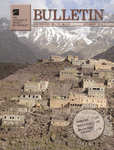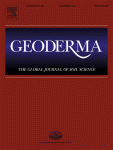Residual regolith derived from the biotite-controlled weathering of Cretaceous tonalite-quartz diorite, Peninsular Ranges, southern California, USA: A case study
Heather Webb and Gary H. Girty
Abstract
Though K-feldspar-free tonalite and quartz diorite are common plutonic rocks in exhumed continental-margin magmatic arc rocks around the globe, how they weather has not been extensively studied. We therefore undertook an investigation aimed at understanding how an approximately 6-m thick section of residual regolith (saprock and overlying Alfisol) developed from Cretaceous K-feldspar-free tonalite and quartz diorite at Santa Margarita Ecological Reserve, southern California, USA. We analyzed three samples of soil, 10 of saprock, and 10 of corestone for their major, trace, and rare earth element compositions. Thin sections of each major textural group also were studied and point counted. Common XRD techniques were used to determine clay mineralogy. Three samples of soil and five of saprock were analyzed for their pH.
Within the saprock, an extensive network of cracks was likely produced by the volumetric expansion that accompanied the conversion of biotite to vermiculite. Migrating near neutral fluids responsible for this conversion resulted in a loss of K mass and affected several trace elements that are commonly found in biotite, but with the exception of an interval between 177 and 270 cm, left most other major, trace, and rare earth elements (REE) little affected. Within the 177 to 270 cm interval, at a depth of 208 cm, relative to the immobile framework, incongruent leaching of plagioclase by acidic solutions, resulted in the losses of Si, Al, Ca, Na, Pb, Sr, and Ga mass. In contrast, more neutral solutions added heavy REE (HREE) and Y mass at 177 to 237 cm depths, while acidic solutions removed REE and Y mass at 270 cm depth. In the soil, acidic solutions attacked plagioclase, biotite, and apatite leaching and removing, relative to the immobile framework, Ca, Na, Mg, K, and P mass. In addition, the dissolution of apatite resulted in depletions in HREE and Y mass. None of the elemental mass removed from the soil accumulated in the directly underlying saprock, and must have been removed from the near vertical plane of sampling.
Within the saprock, the above changes are mostly the result of near neutral pH water/rock interactions occurring within a warm and dry Holocene climate. Identified changes in elemental mass, other than those associated with the conversion of biotite to vermiculite, are localized and are likely the result of the paths taken by fluids with differing pH moving through the complex network of cracks. Any model purporting to describe the evolution of residual regolith must explain such natural complexities.
Heather Webb and Gary H. Girty, February 2016
Detrital zircon U-Pb provenance of the Colorado River: A 5 m.y. record of incision into cover strata overlying the Colorado Plateau and adjacent regions
David L. Kimbrough, Marty Grove, George E. Gehrels, Rebecca J. Dorsey, Keith A. Howard, Oscar Lovera, Andres Aslan, P. Kyle House, and Philip A. Pearthree
Abstract
New detrital zircon U-Pb age distributions from 49 late Cenozoic sandstones and Holocene sands (49 samples, n = 3922) record the arrival of extra-regional early Pliocene Colorado River sediment at Grand Wash (western USA) and downstream locations ca. 5.3 Ma and the subsequent evolution of the river’s provenance signature. We define reference age distributions for the early Pliocene Colorado River (n = 559) and Holocene Colorado River (n = 601). The early Pliocene river is distinguished from the Holocene river by (1) a higher proportion of Yavapai-Mazatzal zircon derived from Rocky Mountain basement uplifts relative to Grenville zircon from Mesozoic supra crustal rocks, and (2) distinctive (∼6%) late Eocene–Oligocene (40–23 Ma) zircon reworked from Cenozoic basins and volcanic fields in the southern Rocky Mountains and/or the eastern Green River catchment. Geologic relationships and interpretation of 135 published detrital zircon age distributions throughout the Colorado River catchment provide the interpretative basis for modeling evolution of the provenance signature. Mixture modeling based upon a modified formulation of the Kolmogorov-Smirnov statistic indicate a subtle yet robust change in Colorado River provenance signature over the past 5 m.y. During this interval the contribution from Cenozoic strata decreased from ∼75% to 50% while pre-Cretaceous strata increased from ∼25% to 50%. We interpret this change to reflect progressive erosional incision into plateau cover strata. Our finding is consistent with geologic and thermochronologic studies that indicate that maximum post–10 Ma erosion of the Colorado River catchment was concentrated across the eastern Utah–western Colorado region.
Biotite controlled chemical alteration of granodioritic-tonalitic saprock: Exploring the use of sieving to enhance copositional linear trends
Jamie W. Purcell, Faithe D. Lovelace, Gary H. Girty
Abstract
The Peninsular Ranges, southern California, USA, commonly contains eroded sections of regolith composed of (1) saprock enclosing corestone or (2) alluvial deposits overlying plutonic/metamorphic basement. In this paper, we present a study focused on evaluating the chemical weathering patterns exemplified by type 1 regolith. In an attempt to enhance the coverage of altered samples about calculated compositional linear trends, the < 45 μm fractions were separated from saprock samples and were chemically analyzed.
Though Alfisol is common within the study area, due to erosional exhumation, such soil is absent at the specific site sampled during this investigation, and colluvium directly overlies saprock and corestones. Mean annual precipitation ranges from 25 cm–51 cm with a mean annual air temperature of 13 °C–18 °C.
In centered p(A), p(CN), and p(K) ternary space, A, CN, and K are compositions representing molar percentages of Al2O3, CaO* + Na2O, and K2O, respectively, in the sum of A, CN, and K. CaO* is the molar percent of CaO following correction for CaO in apatite. Centering preserves the geometrical relationships between plotted samples, but moves them to the center of the ternary diagram.
Saprock samples plot about a linear compositional trend directed away from the p(K) apex. Using orthogonal projection, the average weathering intensity value, t, of the bulk saprock samples is 0.09 (± 0.04). When the sieved < 45 μm fractions are considered along with the bulk saprock samples, a similar linear compositional trend is calculated, but sieved fractions plot closer to the A–CN join, and have an average t-value of 0.89 (± 0.04). Hence, inclusion of the sieved fraction extended the coverage of altered samples about the weathering trend.
Using Na as a reference frame, a statistically significant loss of 10% (+ 9/− 8%) and 14% (+ 6/− 5%) K and P mass, respectively, occurred during the development of saprock. The loss of K mass is attributed to the alteration of biotite to hydroxy-interlayered vermiculite and mixed-layer biotite/vermiculite, while the loss of P mass is due to the dissolution of apatite. In addition, statistically significant increases in Si (6% ± 4%) and LOI (56% (+ 37/− 30%)) mass occurred. The increase in Si mass reflects either, or both, illuviation of small amounts of kaolinite into the prominent crack system observed at the study site, or the addition of pedogenic silica. Such increases are apparently the result of processes that were operative in the now erosionally removed section of Alfisol. The results of the above elemental mass changes produced a statistically significant increase in bulk mass of 5% ± 3%.
The results of our work suggests that the inclusion of < 45 μm fraction chemical data can significantly enhance the coverage of calculated linear compositional trends, and could be a useful investigative tool for future studies.
Jamie W. Purcell, Faithe D. Lovelace, Gary H. Girty, September 2015
Timing and significance of gabbro emplacement within two distinct plutonic domains of the Peninsular Ranges batholith, southern and Baja California
David L. Kimbrough, Marty Grove, and Douglas M. Morton
Abstract
Evaluating the crucial role postulated for mantle-derived mafic magmas in the formation of silicic batholiths requires well-determined igneous crystallization ages from mafic rocks as well as petrologic data reflecting possible mantle source heterogeneities and/or variations in subcrustal processes. The abundant mafic plutons that crop out within the mid-Cretaceous Peninsular Ranges batholith (PRB, southern and Baja California) provide an important opportunity to investigate the relationship of mafic and silicic magmatism in Cordilleran batholiths. Zircon U-Pb laser ablation inductively coupled plasma mass spectrometry ages are reported for 24 samples of PRB gabbro collected throughout its 1400-km-long extent. The samples span the entire compositional spectrum of PRB gabbro from cumulate olivine gabbro with <10 ppm whole rock Zr content, to gabbronorite, to more fractionated hornblende gabbro. Eighteen of the samples are from the western zone “gabbro belt” of the batholith including the type locality for San Marcos Gabbro, while six are from the eastern zone where gabbro is rare, composing <1% of the outcrop area. The morphology of zircon in PRB gabbro ranges from anhedral fragments to euhedral grains, and this zircon has distinctly lower uranium concentrations and higher Th/U ratios than zircon from PRB granitoids. Most samples exhibit simple U-Pb systematics, but several contain inherited or entrained zircons, and two eastern gabbro samples contain distinctly bimodal age populations. Weighted mean 206Pb/238U zircon ages are interpreted as crystallization ages and range from 130.5 ± 1.5 Ma to 100.2 ± 3.0 Ma for western zone samples. The ages demonstrate that gabbros were emplaced throughout the ~30 m.y. interval during which the bulk of the western zone was constructed, and conflict with the earlier interpretation of western gabbros as mafic forerunners that preceded emplacement of granitoid plutons. Eastern zone gabbros, in contrast, yield U-Pb ages that range mostly from 109.4 ± 2.9 Ma to 97.8 ± 2.3 Ma, narrowly predating the ca. 92–98 Ma eastern zone tonalite-trondhjemite-granodiorite batholith flareup, and thus may have played a role in crustal thickening and triggering of the flareup. Despite their partially cumulate character, whole rock major and trace element compositions of PRB gabbro closely match high-alumina olivine tholeiite and arc basalt and basaltic andesite from modern arcs. Gabbros from the west and east sides of the batholith, transverse to regional strike, have similar nearly flat rare earth element patterns that reflect derivation from a common partially contaminated depleted mantle source. The apparent across-strike petrologic uniformity of the gabbros contrasts strongly with PRB granitoids, which are well known for across-strike asymmetries in trace elements, initial 87Sr/86Sr, and δ18O, reflecting progressively deeper partial melting of mafic source rocks from west to east with additional input from a high-18O, high-87Sr end member on the east side of the batholith. The western PRB gabbros represent a plausible deep crustal source composition for derivation of western granitoids by partial melting or fractional crystallization. For the eastern batholith, the mafic source region requires modification by input of accretionary complex supracrustal rocks delivered via forearc subduction erosion underthrusting.
 David L. Kimbrough, Marty Grove, and Douglas M. Morton, July 2014
David L. Kimbrough, Marty Grove, and Douglas M. Morton, July 2014




